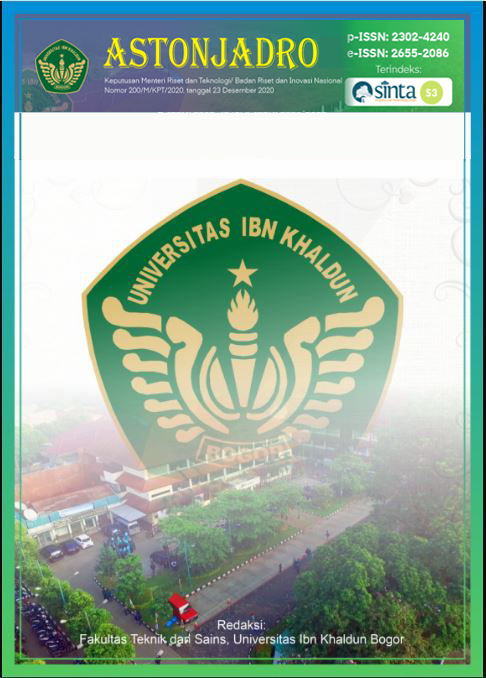Application of the Green Building Concept (BGH) in High-Rise Office Buildings Based on Hybrid Dynamics to Improve Cost Performance
DOI:
https://doi.org/10.32832/astonjadro.v13i3.15941Keywords:
offices; green buildings; hybrid systems on cost performanceAbstract
This research aims to determine the application of the green building concept (BGH) in multi-story office buildings based on hybrid dynamics to improve cost performance. The method used in this research is a quantitative method with primary and secondary data types. The sampling technique used purposive sampling with 163 individuals involved in the Ginza Business Loft Jababeka area. The data management and analysis techniques used are outer model analysis (measurement model) and inner model analysis (structural model) using the SmartPLS 3 Multivariate Structural Equation Model (SEM) technique. Partially, the results of this research show that X2.2.21 has a P-Values value of 0.000 for X2.2 has a P-Values value of 0.000 on 0.000, it can be concluded that X3.2.2 has a strong influence on variable X3.2 in the model. The variable X2.3.6 also has a P-value value of 0.000, meaning that X2.3.6 has a significant effect on variable X2. Variable X3.1.6 has a P-value of 0.000 for variable X3, indicating that the auditor quality variable has a significant effect on variable X3. Furthermore, variable Y2.2 has a P-value value of 0.000, indicating that this variable has a significant influence on variable Y2. These results illustrate that variable Y2.2 has a strong influence on variable Y2 in the context of the research model. Overall, the results of the P-Values analysis show that the variables mentioned above have a significant influence on the variables measured.
References
Anonim. (2020). The benefit of green building for cost efficiency. International Journal of Financial, Accounting, and Management, 1(4). https://doi.org/10.35912/ijfam.v1i4.152
Adriyatno, J. (2022). ANALISIS BIAYA PERUBAHAN SPESIFIKASI FASAD GREEN BUILDING DENGAN METODE VALUE ENGINEERING. NALARs, 21(1), 57. https://doi.org/10.24853/nalars.21.1.57-66
Aghili, N., & Amirkhani, M. (2021). SEM-PLS Approach to Green Building. Encyclopedia, 1(2), 472–481. https://doi.org/10.3390/encyclopedia1020039
Ahmad, P., Misni, A., Kamaruddin, S. M., & Daud, N. (2017). Green Neighbourhood Adaptive Model for Urban Living: A Conceptual Review. Environment-Behaviour Proceedings Journal, 2(5), 55. https://doi.org/10.21834/e-bpj.v2i5.690
Bahadure, S., & Kotharkar, R. (2018). Framework for measuring sustainability of neighbourhoods in Nagpur, India. Building and Environment, 127, 86–97. https://doi.org/10.1016/j.buildenv.2017.10.034.
Bahadure, S., & Kotharkar, R. (2018). Framework for measuring sustainability of neighbourhoods in Nagpur, India. Building and Environment, 127, 86–97. https://doi.org/10.1016/j.buildenv.2017.10.034
Elgadi, A. A., Ismail, L. H., Abass, F., & Ali, A. (2016). Developing Urban Environment Indicators for Neighborhood Sustainability Assessment in Tripoli-Libya. IOP Conference Series: Materials Science and Engineering, 160, 012046. https://doi.org/10.1088/1757-899X/160/1/012046.
Erma Suryani. (2006). Pemodelan & simulasi / Erma Suryani. Yogyakarta: Graha Ilmu.
GBCI. (2015). GREENSHIP RATING TOOLS untuk KAWASAN VERSI 1.0. Automation in Construction, 78(62–82).
Hui, E. C. M., Zhong, J. W., & Yu, K. H. (2012). The impact of landscape views and storey levels on property prices. Landscape and Urban Planning, 105(1–2), 86–93. https://doi.org/10.1016/j.landurbplan.2011.12.002
Hussain, T., Abbas, J., Wei, Z., Ahmad, S., Xuehao, B., & Gaoli, Z. (2021). Impact of Urban Village Disamenity on Neighboring Residential Properties: Empirical Evidence from Nanjing through Hedonic Pricing Model Appraisal. Journal of Urban Planning and Development, 147(1). https://doi.org/10.1061/(ASCE)UP.1943-5444.0000645.
Imron, A. I., & Husin, A. E. (2021). Peningkatan Kinerja Biaya Berbasis Value Engineering Pada Proyek Green Hospital. Jurnal Aplikasi Teknik Sipil, 19(3), 323. https://doi.org/10.12962/j2579-891X.v19i3.9144.
Islam, M. S., Hossain, R., Morshed, M. M., & Afrin, S. (2020). The value of environmental (dis)amenities in the urban housing market: Evidence from Khulna, Bangladesh. Journal of Urban Management.
https://doi.org/10.1016/j.jum.2020.02.001.
Kineber, A. F., Othman, I., Oke, A. E., Chileshe, N., & Zayed, T. (2021). Exploring the value management critical success factors for sustainable residential building – A structural equation modelling approach. Journal of Cleaner Production, 293, 126115. https://doi.org/10.1016/j.jclepro.2021.126115
Latief, Y., Berawi, M. A., Van Basten, Riswanto, & Budiman, R. (2017). Construction Performance Optimization toward Green Building Premium Cost Based on Greenship Rating Tools Assessment with Value Engineering Method. Journal of Physics: Conference Series, 877, 012041. https://doi.org/10.1088/1742-6596/877/1/012041.
Lin, X., & Wang, P. (2020). Relationship between Rising Housing Prices and Reduction in Urban Agglomeration. Journal of Urban Planning and Development, 146(3). https://doi.org/10.1061/(ASCE)UP.1943-5444.0000596.
Molina, G., Donn, M., Johnstone, M.-L., & MacGregor, C. (2020). Green Labels in Housing: Further Evidence on Their Effectiveness. Journal of Sustainable Real Estate, 12(1), 69–83. https://doi.org/10.1080/19498276.2021.1957417.
Qu, S., Hu, S., Li, W., Zhang, C., Li, Q., & Wang, H. (2020). Temporal variation in the effects of impact factors on residential land prices. Applied Geography, 114, 102124. https://doi.org/10.1016/j.apgeog.2019.102124.
Downloads
Published
How to Cite
Issue
Section
License
Copyright (c) 2024 ASTONJADRO

This work is licensed under a Creative Commons Attribution-ShareAlike 4.0 International License.
Paper submitted to ASTONJADRO is the sole property of the Astonjadro Journal. Unless the author withdraws the paper because he does not want to be published in this journal. The publication rights are in the journal Astonjadro.ASTONJADRO
LICENSE
This work is licensed under a Creative Commons Attribution-ShareAlike 4.0 International License.
Based on a work at http://ejournal.uika-bogor.ac.id/index.php/ASTONJADRO













